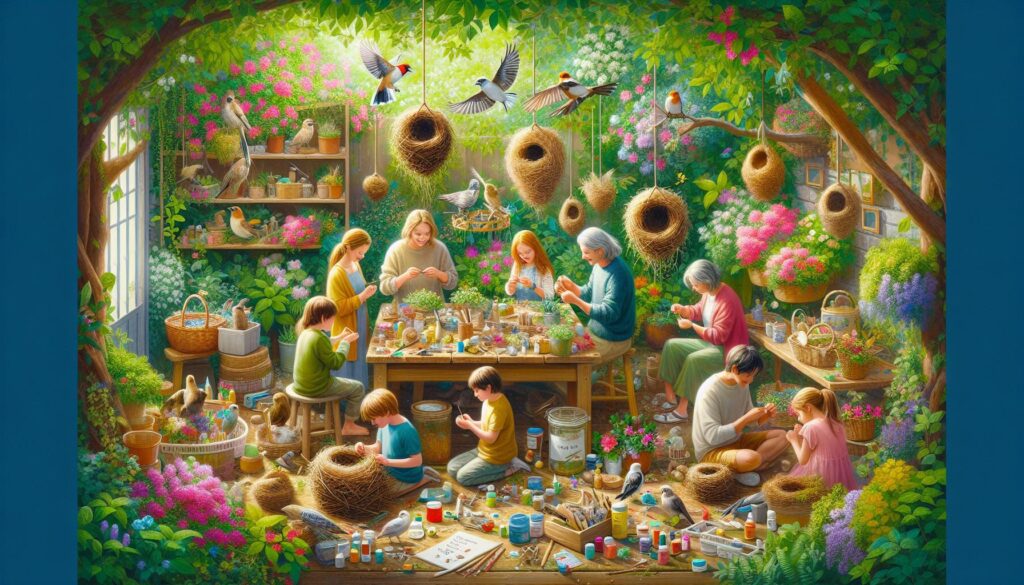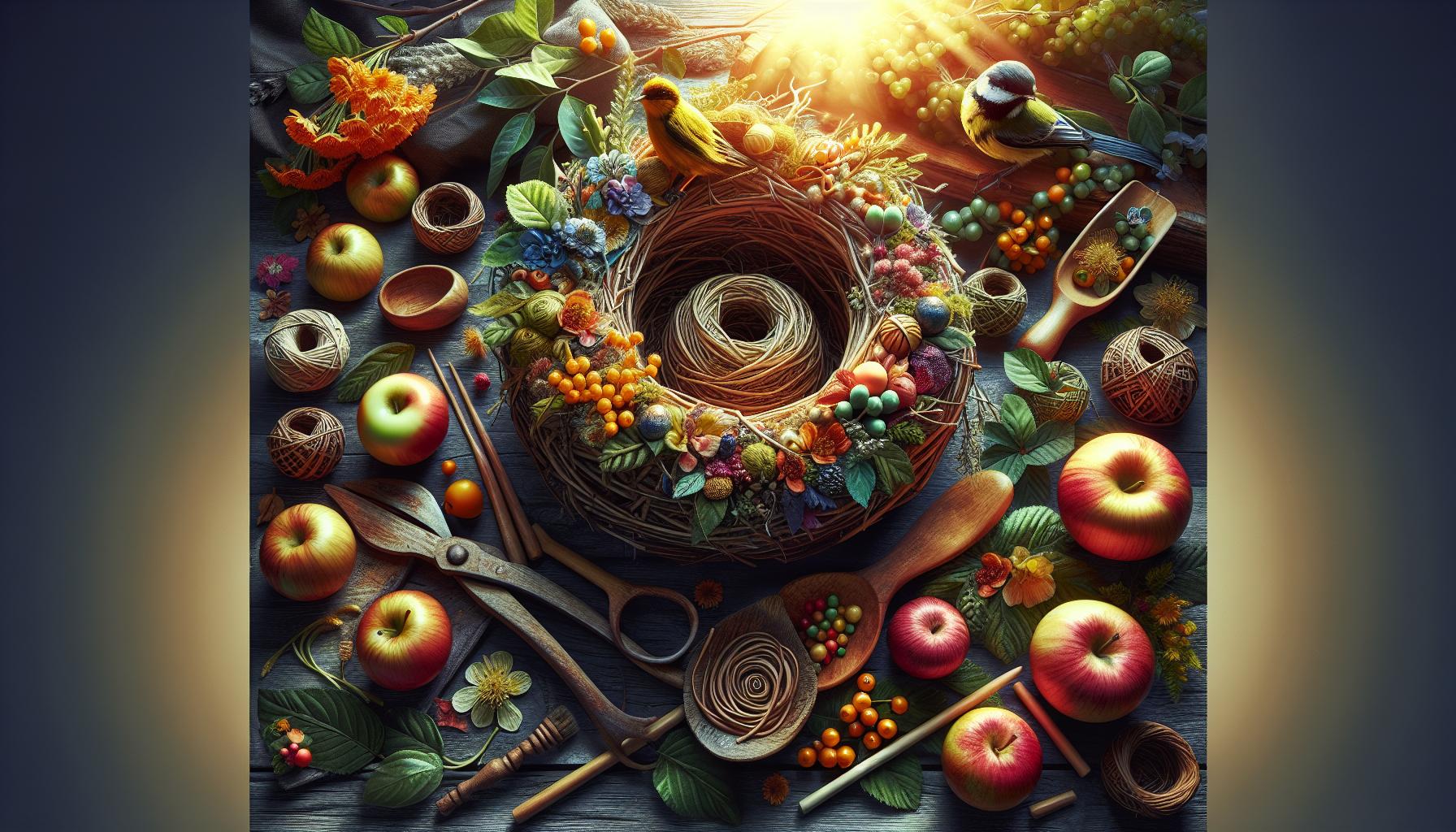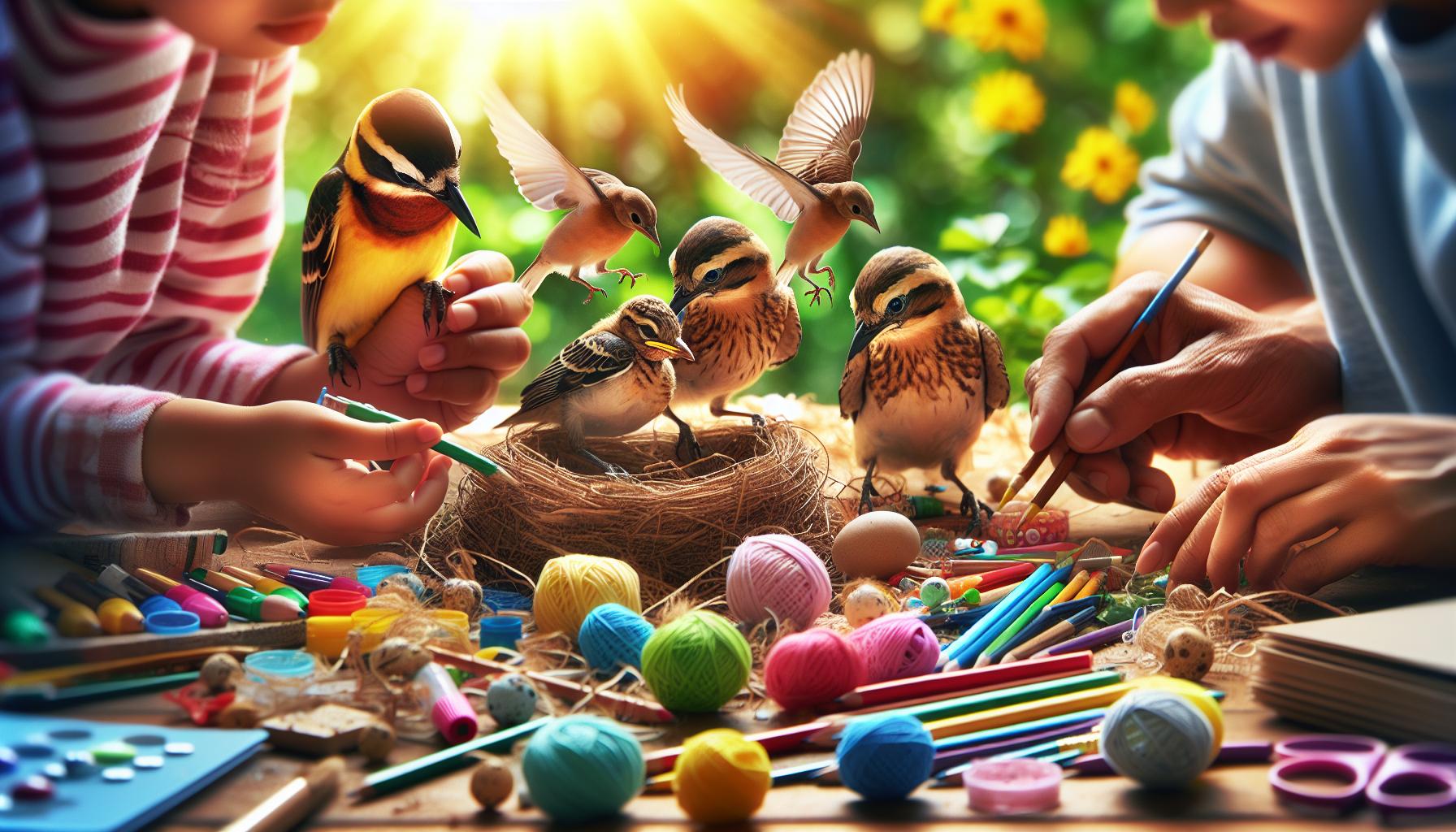Who Made That Nest? A Fun Guide to Bird Nest Identification
Ever strolled through a park and stumbled upon a curious little nest dangling from a branch, pondering, ”Who made that?” If so, you’re not alone! Welcome to “Who Made That Nest? A Fun Guide to Bird Nest Identification,” where we swap the boring birdwatching handbook for a lighthearted romp through the enchanting—and sometimes downright hilarious—world of avian architecture. In this guide, you’ll not only learn to identify nests crafted by our feathered friends but also gain a newfound recognition for their remarkable (and often bizarre) building skills. So, grab your binoculars, don your “bird nerd” cap, and prepare for a delightful dive into a world where twigs, mud, and a little bit of creativity come together in the most adorable ways. get ready to impress your friends (and maybe even a few chirpy residents) with your newfound nest knowledge!
Understanding the Importance of Bird Nest Identification
Bird nest identification serves as a engaging entry point into the rich tapestry of avian life. Understanding who built a nest can reveal not only the species involved but also insights into their behavior, habitat preferences, and breeding habits. Recognizing different nests allows bird enthusiasts and researchers alike to monitor local bird populations and contribute to conservation efforts. For instance, identifying a small, cup-shaped nest often points to species like the American Robin or the Song Sparrow, which prefer nesting in shrubs and trees, thereby offering clues about the ecological balance of your environment.
When embarking on your nest identification journey, consider the following key aspects:
- Material Used: Nests can be constructed from grass, twigs, mud, or even human-made items. the materials often reflect both the species and their surroundings.
- Location: Nests can be found in various places, such as trees, shrubs, or on buildings. Observing the nesting site can further aid in pinpointing the bird species.
- Size and Shape: Noting the dimensions and structure (e.g., cup, dome, or platform) can help differentiate between species with similar nesting habits.
| Nest Type | Common Builders |
|---|---|
| Cup nest | American Robin, House Finch |
| Dome Nest | Song Sparrow, Common Yellowthroat |
| Platform Nest | Osprey, Bald Eagle |
Common Types of Bird Nests and Their Unique Features
Bird nests come in a variety of shapes and sizes, each uniquely suited to the bird species that builds them. The cup nest,frequently enough seen in species like robins and sparrows,is a classic rounded structure made from grass,mud,and feathers. This design helps to cradle the eggs,providing warmth and security. In contrast, the platform nest is typically built by larger birds such as hawks and owls, featuring a flat base that can hold multiple eggs, sometimes adorned with twigs and branches for added strength. another fascinating type is the pendulum nest, skillfully woven by some species of weaver birds. These nests dangle from tree branches, offering protection from predators and high winds while being a stunning showcase of avian engineering.
Many birds also exhibit intriguing adaptations in their nesting habits.As a notable example, burrow nests, created by species like puffins and kingfishers, provide excellent concealment from predators. These birds excavate deep tunnels into the earth or riverbanks, where they lay their eggs in protective chambers. Conversely, suspended nests hang from tree branches, frequently enough seen in species like oriole and some finches, blending seamlessly with foliage.the materials used in nest construction often reflect the local environment; birds will gather available elements such as leaves, twigs, spider silk, and even human-made items like string or paper. Understanding these unique nesting characteristics not only enhances our appreciation for these remarkable creatures but also aids in identifying which birds inhabit a particular area.
Identifying Nest Materials: What They Reveal About the Builder
When observing a nest, the materials used can provide profound insights into the builder’s identity and habitat preferences. Different birds are known for distinct nesting behaviors, and the materials they choose reflect not only their physical characteristics but also their ecological needs. For example,songbirds often use finely woven grasses,feathers,and even discarded human materials such as string or paper. These soft components help conceal the nest while also providing a warm environment for the chicks. Conversely, woodpeckers create nests in tree cavities, utilizing wood shavings they produce while excavating, highlighting their preference for old, decaying trees that provide both shelter and food sources.
Each type of nest material can reveal much about the bird’s lifestyle and adaptations. For instance,a nest adorned with large twigs and sticks often indicates a builder that requires durability,such as a hawk or eagle. These birds need the strength to withstand harsh weather conditions and potential predators. In contrast, nests constructed with mud and grass, like those of swallows, show a clever use of local resources for both insulation and moisture regulation. The following table summarizes notable nest materials and the corresponding builders:
| Builder | Common Nest Materials |
|---|---|
| American Robin | Grass,mud,feathers |
| Blue jay | Twigs,leaves,pine needles |
| House Sparrow | Straw,paper,plastic |
| Barn Owl | Pellets,feathers,straw |
Nest Locations: Where Different Birds Choose to Build
Birds exhibit remarkable diversity in their nesting habits, frequently enough selecting locations that reflect their unique lifestyles and environmental needs. Some species favor the safety of dense foliage, making the heart of a bush or tree their ideal nesting site. For instance, the American Robin typically constructs its nests in trees or shrubs, using soft materials like grass and mud to create a sturdy bowl-shaped structure.Other species, such as the Barn Swallow, opt for more architectural choices by building their nests under eaves or in barn spaces, utilizing mud pellets to fashion their homes. the choice of location not only protects their eggs from predators but also provides the necessary warmth and shelter for their young.
On the other hand, some birds have adapted to rely on urban settings. The House Sparrow, for example, can often be found nesting in man-made structures such as gutters, vents, or even inside buildings. Their adaptability in habitat selection underscores their resilience. Similarly, species like the Eastern Bluebird prefer open fields and often use cavities left by other animals or man-made birdhouses. The following table summarizes various bird species and their preferred nesting locations:
| Bird Species | Preferred Nest Location |
|---|---|
| American Robin | Trees and shrubs |
| Barn Swallow | Under eaves, barns |
| House Sparrow | Urban structures |
| Eastern Bluebird | Cavities, open fields |
Seasonal Patterns in Nesting Behavior
Nesting behavior among birds is profoundly influenced by seasonal changes. As the warmth of spring arrives, many birds commence their nesting activities, timing their reproductive cycles to align with environmental cues such as temperature and food availability. During this period, various species exhibit distinct patterns in material selection and nest construction, frequently enough utilizing resources abundant in their surroundings. As an example, robins prefer grass and mud to create sturdy structures, while oriole nests are typically woven from plant fibers, creating exquisite hanging masterpieces in trees. both reflect how birds adapt to climatic conditions to optimize their nesting success.
As seasons progress, the nesting patterns can shift dramatically. In summer, many birds will have already fledged their young, and some species may even undertake a second nesting attempt if conditions remain favorable. By fall, nesting behavior decreases significantly as birds prepare for migration or settle into winter roosts. Notably, species such as American kestrels may reuse existing cavities, showcasing a different approach to nesting as they respond to declining food resources. Understanding these fluctuations offers insight into the life cycles of birds and highlights the importance of monitoring seasonal changes in their behavior.
Tips for Observing and Identifying Nests Safely
When venturing out to observe and identify bird nests, it’s essential to do so with care and respect for wildlife. To enhance your nest-watching experience while minimizing disturbance, keep in mind these important practices:
- Maintain Distance: Use binoculars or a camera with a zoom lens to view nests without getting too close. This helps prevent stress to the birds and ensures their natural behavior is undisturbed.
- Visit During the Right Time: early mornings or late afternoons are generally the best times for observing bird activities. Keep a respectful distance, notably during nesting season when birds are most vulnerable.
- Avoid Touching Nests: Touching or handling nests can transfer human scent and introduce potential dangers to the eggs or young birds inside.
Another crucial aspect is the ethical consideration of the impact your observations may have on local bird populations. ensure that your enthusiasm for observing nests does not lead to interference with their natural habitats. Here are a few additional guidelines for responsible nest observation:
- Limit Repeated Visits: Frequent disturbance can drive birds away from their nests. Limit your visits to ensure mother birds continue to care for their young.
- Educate Others: Share your knowledge about nests and the importance of preserving bird habitats with your community, fostering a culture of duty in wildlife observation.
- Report Findings: If you come across a new nest, consider reporting it to local birdwatching groups or wildlife authorities to assist in monitoring and conservation efforts.
Conservation Implications: Protecting Nesting Birds and Their habitats
As we delve into the fascinating world of bird nests, it’s essential to recognise their crucial role in the broader ecosystem and our responsibility toward conserving these unbelievable avian architects. Protecting nesting birds and their habitats is vital not only for maintaining biodiversity but also for ensuring the health of our environmental systems.When we understand the different types of nests and the unique needs of various bird species, we can better advocate for and implement conservation measures. For instance, urban advancement and habitat destruction pose significant threats to nesting sites, making it imperative to create awareness about bird-friendly practices, such as protecting natural landscapes and providing safe nesting opportunities.
Engaging local communities in conservation efforts enhances the chances of accomplished nesting site protection. Simple actions can make a significant difference,such as:
- Educating the public about native bird species and their nesting habits.
- Encouraging responsible landscaping that supports local wildlife habitats.
- Promoting the installation of birdhouses that are suited for specific species.
Furthermore, collaborating with conservation organizations can lead to effective programs that monitor bird populations and their nesting success rates. the table below highlights some common bird species, their preferred nesting habitats, and the conservation strategies that can aid their protection.
| bird Species | Nesting Habitat | Conservation Strategy |
|---|---|---|
| American Robin | Trees, shrubs, and buildings | Reduce pesticide use |
| Eastern bluebird | Open fields and meadows | Install bluebird boxes |
| Barn Owl | Open farmlands and barns | Preserve old barns |
By fostering a collective commitment to protecting nesting birds and their habitats, we can ensure that future generations will admire the beauty and diversity of avian life while playing an active role in a healthy ecosystem.
Engaging with Local Birdwatching Communities for Shared Knowledge
Becoming an active member of local birdwatching communities is a remarkable way to enhance your bird nest identification skills. Engaging with fellow enthusiasts allows you to exchange vital insights about the various nesting behaviors and habitats specific to your region. Participate in local birding groups or conservation projects, where you can learn about the specific bird species prevalent in your area and their nesting habits. By attending workshops or field trips organized by these communities, you can observe firsthand the nests in different environments and gain practical knowledge that books alone may not offer. Here are some of the benefits of engaging with local birdwatchers:
- Shared Experiences: Learn from the firsthand experiences of other birders, including their successes and challenges in identifying nests.
- Networking Opportunities: Build connections with experienced birdwatchers who can mentor you or guide you to valuable resources.
- Resources Access: Gain access to local databases, guides, and even private collections of nest photos and descriptions that can aid in identification.
Community involvement also fosters a collaborative spirit where everyone contributes to a common goal: the conservation and study of avian species. Many local chapters of national organizations host citizen science initiatives that encourage members to document nest observations. These contributions help create larger databases on bird nesting patterns and behaviors, which are crucial for researchers. Consider attending meetings or joining online platforms where local birdwatchers convene to share their findings. You might discover that local experts are willing to share their unique lists of common nests and their identifying features, as outlined in the table below:
| Bird Species | Nest Characteristics |
|---|---|
| American Robin | Built with mud and grass; frequently enough found in shrubs or trees. |
| barn Swallow | Made of mud and debris; usually under eaves of buildings. |
| House Finch | Constructed of grass, feathers, and birdseed wrappers; commonly in hanging planters. |
Q&A
what are the primary materials used by birds to build their nests?
Birds are remarkably resourceful when it comes to nest-building materials. The choice of materials often depends on the bird species, available resources in their habitat, and the specific environmental conditions they face. Common materials include twigs, grass, mud, leaves, feathers, and even human-made items like string and paper. For example,the American Robin typically uses mud and grass to create a sturdy cup-shaped nest,while the industrious House Sparrow may incorporate bits of plastic and paper into its construction,displaying adaptability to urban environments.
Additionally, some species have unique materials that serve specific purposes. The Bowerbird is famous for its intricate nests,or “bowers,” built primarily for attracting mates. Not only does this bird gather twigs and leaves, but it also collects colorful items, including shells and bottles, to adorn its nest, appealing to potential partners. This behavior showcases how materials can serve as a form of interaction and expression within the avian world.
How can you identify bird nests by their shape and structure?
Bird nests come in various shapes and structures, frequently enough categorized by their form and function. The most common types include open cup nests, platform nests, and cavity nests, each reflecting the unique evolutionary adaptations of the species that built them.As an example,the open cup nest,which resembles a small bowl,is typical for songbirds like sparrows and warblers. These nests are often constructed using soft materials to provide insulation and comfort for the eggs and fledglings.
On the other hand, platform nests, which are wider and flattish, are generally built by birds such as eagles and hawks. These nests are constructed high in trees or on cliffs, offering protection from predators.Cavity nests, found in woodpeckers and some owls, utilize existing hollows in trees or man-made structures. Each nest type grants insights into the bird’s lifestyle and habitat preferences—the structure not only serves as a home but also plays a crucial role in the reproductive success of the species.
Why is it critically important to know which birds built specific nests?
Understanding which birds built specific nests is crucial for a variety of reasons, including ecological research and conservation efforts. Identifying nests helps ornithologists and wildlife enthusiasts monitor bird populations and their breeding successes. For example, if a certain species is declining, knowing its nesting habits can lead to focused conservation actions, such as habitat restoration or nest protection measures.
Moreover, recognizing nests can enhance our appreciation for biodiversity and promote environmental stewardship.Engaging communities in activities like nest identification fosters a connection with nature and raises awareness about the importance of avian conservation. Knowing which birds are nesting in a particular area can also guide practices in urban planning and development to minimize disruption to bird habitats, ensuring the preservation of these valuable populations.
What role does location play in the type of nest a bird builds?
The location where a bird builds its nest significantly influences the type of nest constructed. Different habitats provide varying levels of safety from predators, as well as access to materials and food sources for the parents and their young. For instance, ground-nesting species, such as some plovers, may choose sandy or gravelly areas to avoid aerial predators, using camouflage to conceal their nests.
Conversely, tree-nesting birds like orioles or wrens prefer the safety of tree branches, which provide elevation and cover against ground-based threats. The proximity to water can also dictate nesting preferences; species like the Kingfisher often build nests near rivers or lakes to offer easy access to food and appropriate nesting substrates. Hence,understanding these dynamics can shed light on specific species’ behaviors and the ecological pressures they face in their environments.
How do human activities impact bird nesting habits and success?
Human activities have a profound effect on bird nesting habits and overall success rates. Urbanization,deforestation,and agricultural expansion can lead to habitat loss,diminishing the places where birds can safely nest. as a notable example, the decline in available trees has negatively impacted cavity-nesting birds like woodpeckers and owls, while the increase in impermeable surfaces in urban areas reduces the amount of natural nesting materials and safe sites.
moreover, pollution and climate change contribute to altering habitats and food resources. Birds are often sensitive to shifts in temperature and weather patterns, impacting their nesting timelines and survival rates of chicks. Research has shown that some species may even resort to building nests out of disjointed materials or in suboptimal locations due to these changes, leading to lower survival rates. By recognizing the risks presented by human activities, we can take actionable steps to mitigate these effects, such as engaging in habitat restoration and supporting conservation initiatives that help protect crucial avian breeding environments.
What are some common signs of a nearby bird nest?
Recognizing the signs of a nearby bird nest can be a delightful experience for nature lovers and a valuable skill for conservationists. One of the most obvious indicators is the presence of adult birds frequently flying to and from a specific area, especially if they are carrying food or building materials. Observing bird behavior during the nesting season,typically in spring,can provide cues—parent birds often exhibit protective or agitated behavior if a nest is approached.
Additionally, physical signs may include droppings or discarded nest materials, such as feathers, twigs, or bits of fabric near a tree or shrub. Some nests leave behind a trail of feathers, which are often used to line the nest for insulation and comfort. While searching for nests, it’s essential to respect their privacy; maintaining a safe distance not only protects the birds but also ensures minimal disturbance to their nesting activities. By understanding these signs, birdwatchers and enthusiasts can enjoy the fascinating behaviors of avian families while contributing to their protection.
The Way Forward
As we conclude our exploration into the fascinating world of bird nests, it’s clear that these intricate structures are more than just homes; they are a testament to the incredible adaptability and ingenuity of our avian friends. Armed with the knowledge and insights shared in this guide, you can now embark on your own nest-identifying adventures. Whether you’re observing the delicate artistry of a hummingbird’s tiny nest or marveling at the engineering prowess of an eagle’s aerie, each finding enriches our understanding of bird behavior and their ecosystems. So next time you spot a nest, take a moment to appreciate the craftsmanship behind it and the diligent efforts of the birds that created it. remember, the beauty of nature lies not just in the birds themselves, but in the homes they build and the stories they tell. Happy bird-watching!






